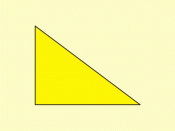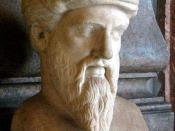Math and Music. In thinking of these concepts, many people do not see any relation between the two. In reality, however, mathematics has a tremendous effect on music and they are closely intertwined. The relationship between these two arts, though it might be hard to connect at first, is, after a bit of study, unmistakable.
Pythagoras was the first to discover the mathematical basis for music. He discovered that there was a connection between the length of a string (such as on a guitar) and the pitch of its vibrating note. By conducting experiments with a musical instrument called a monochord, a stretched string with a movable bridge, Pythagoras found that the shorter the string, the higher the pitch (frequency). He then moved the bridge to shorten the string to half of its original length. He found that the frequency of the second note (shorter string) divided by the frequency of the first note (longer string) equaled a ratio of 2:1, and that string-length of the second note divided by the string-length of the first note the equaled a ratio of 1:2.
Thus, he found that an octave (a note eight full tones above a given note) is obtained by shortening the string to one half of its original length, thereby doubling the frequency. Pythagoras also found that in addition to the octave, the fifth and fourth notes of the octave produce harmony, or are pleasing to the ear. To obtain these notes, the ratio of new length to original length should be 2:3 for a fifth and 3:4 for a fourth.
Interestingly, the strings of a violin are tuned a fifth apart, men and women often sing a fifth apart, and most harmony singing involves octaves and fifths. Another way to look at this is if you blow...


